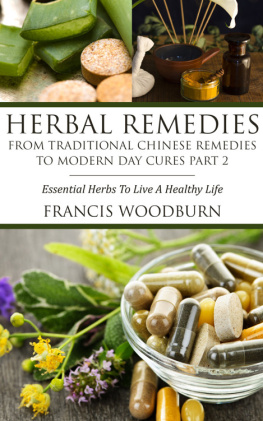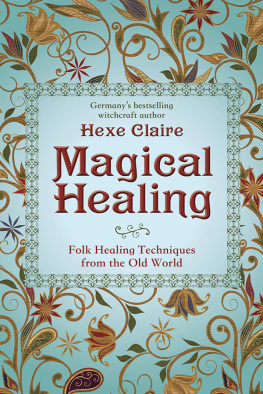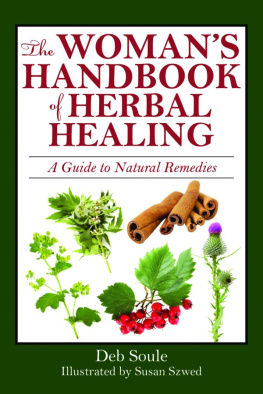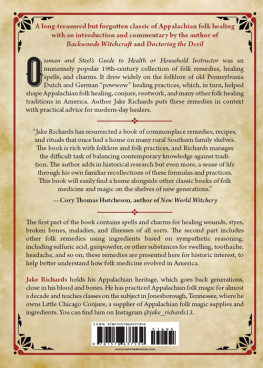Foxfire Americana Library - Mountain Folk Remedies
Here you can read online Foxfire Americana Library - Mountain Folk Remedies full text of the book (entire story) in english for free. Download pdf and epub, get meaning, cover and reviews about this ebook. City: New York, year: 2011, publisher: Knopf Doubleday Publishing Group;Anchor Books, genre: Home and family. Description of the work, (preface) as well as reviews are available. Best literature library LitArk.com created for fans of good reading and offers a wide selection of genres:
Romance novel
Science fiction
Adventure
Detective
Science
History
Home and family
Prose
Art
Politics
Computer
Non-fiction
Religion
Business
Children
Humor
Choose a favorite category and find really read worthwhile books. Enjoy immersion in the world of imagination, feel the emotions of the characters or learn something new for yourself, make an fascinating discovery.

- Book:Mountain Folk Remedies
- Author:
- Publisher:Knopf Doubleday Publishing Group;Anchor Books
- Genre:
- Year:2011
- City:New York
- Rating:4 / 5
- Favourites:Add to favourites
- Your mark:
- 80
- 1
- 2
- 3
- 4
- 5
Mountain Folk Remedies: summary, description and annotation
We offer to read an annotation, description, summary or preface (depends on what the author of the book "Mountain Folk Remedies" wrote himself). If you haven't found the necessary information about the book — write in the comments, we will try to find it.
Foxfire Americana Library: author's other books
Who wrote Mountain Folk Remedies? Find out the surname, the name of the author of the book and a list of all author's works by series.
Mountain Folk Remedies — read online for free the complete book (whole text) full work
Below is the text of the book, divided by pages. System saving the place of the last page read, allows you to conveniently read the book "Mountain Folk Remedies" online for free, without having to search again every time where you left off. Put a bookmark, and you can go to the page where you finished reading at any time.
Font size:
Interval:
Bookmark:
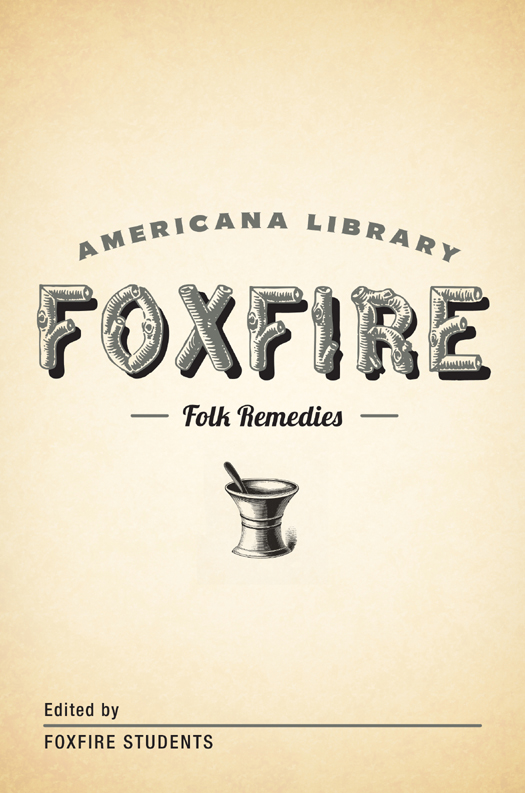
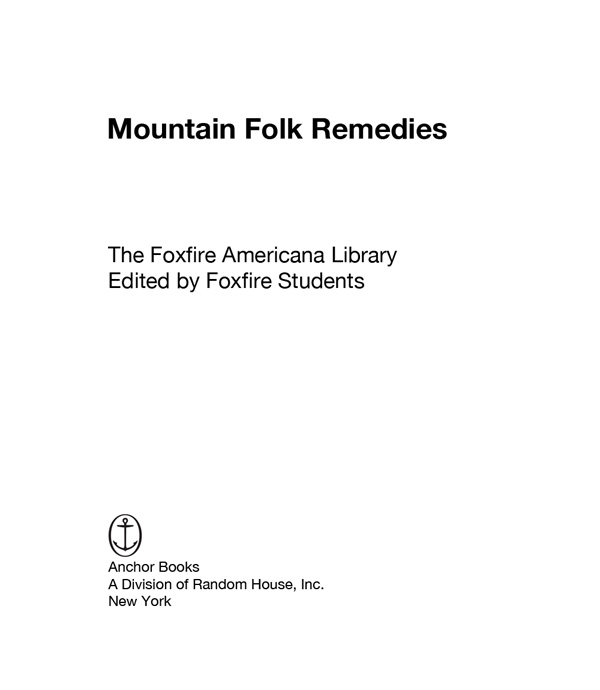
ANCHOR BOOKS EDITION, SEPTEMBER 2011
Copyright 1977, 1999
All rights reserved. Published in the United States by Anchor Books, a division of Random House, Inc., New York.
Anchor Books and colophon are registered trademarks of Random House, Inc.
Remedies, Herb Doctors, and Healers originally appeared in Foxfire 9, 1977 by The Foxfire Fund, Inc. Reprinted by permission of Random House, Inc.
Wild Plant Uses originally appeared in Foxfire 11, 1999 by The Foxfire Fund, Inc. Reprinted by permission of Random House, Inc.
eISBN: 978-0-307-94828-1
v3.1
Concerning the remedies we have printed, a note of caution is appropriate: we have tested none of these remedies ourselves, and though we do not dispute their efficacy, we must warn thatdue to the pressure of the interview situations, or tape noise and interference, or the failure of the human memoryessential ingredients or quantities may have been misunderstood or left out; and the names of ingredients such as plants, because they are frequently called my their common colloquial names around here, may be misleading.
In addition, several of the plants advocated (yellow ladyslipper, for example) may be on the endangered species lists.
For the above reasons, we cannot advocate or stand behind the actual use of these remedies, and we do not encourage you to employ them. We present them here purely for their historical and cultural interest, not as viable alternatives to modern medicinal products.
For almost half a century, high school students in the Foxfire program in Rabun County, Georgia, have collected oral histories of their elders from the southern Appalachian region in an attempt to preserve a part of the rapidly vanishing heritage and dialect. The Foxfire Fund, Inc., has brought that philosophy of simple living to millions of readers, starting with the bestselling success of The Foxfire Book in the early 1970s. Their series of fifteen books and counting has taught creative self-sufficiency and has preserved the stories, crafts, and customs of the unique Appalachian culture for future generations.
Traditionally, books in the Foxfire series have included a little something for everyone in each and every volume. For the first time ever, through the creation of The Foxfire Americana Library, this forty-five-year collection of knowledge has been organized by subject. Whether down-home recipes or simple tips for both your household and garden, each book holds a wealth of tried-and-true information, all passed down by unforgettable people with unforgettable voices.
Some of the plants listed here are very rare, and some are even on the endangered species list. Please be respectful of future generations and use a conservative approach when you go a-gatherin, as Charles Thurmond does. I prefer to go out and get my own herbs. When I go gather the herbs, I use the old Cherokee way of being conservative. I make sure that I find four of the plants before Ill take one. This way I know that I will leave three plants to reproduce. You can take part of the root of most of the plants and leave part, and it will continue to grow. Always put something back.
This reverent relationship with the land and the belief that God owns and provides all continue to be integral parts of the simple lifestyle of the people of the rural Appalachians. Having knowledge of the land and the wild plants available for consumption is still a source of pride for the mountain people, who strive to live simple, self-sufficient lives. While some cultures or geographical areas attempt to shelter their resources, the Southern Appalachian people have always been willing to share their wisdom and skill in the old ways with anyone eager to learn.
Charles Thurmond demonstrated this willingness through a recent interview. Much of his knowledge came from ancestors who shared with him. My grandmother was a midwife and had at least one herbal cure for everything. Her having a good bit of Cherokee blood in her caused her to know a lot of the herbs. Grandma used to take me out to show me things in the woods and tell me what they were good for.
My grandma taught me some of her herbal cures, but most of it Ive picked up since then. When you are a child, you dont listen enough. I remember some of what Grandma taught me. My father and uncles have supplemented my herbal education. I go to the doctor occasionally, but I like doctors that dont go overboard with antibiotics and things like that. I dont medically treat people, but I talk about herbs with em. I teach people about herbs so they can learn for themselves.
My grandma had numerous cures for everything, usually two or three. There are many ways to prepare various herbs. Whether you want it prepared cold, warm, or hot depends on what you are treating. If it is cold, it takes longer to work, but it will work longer in your system. Most herbs can be boiled. You soak some herbs. Alcohol will take the chemicals and things inside the herbs out. It depends on how you fix them and, most importantly, how you use them.
While the knowledge of those who graciously contributed information to this section is not questioned, we must caution readers that these are personal uses and experiences with wild plants, and we in no way guarantee accuracy, effectiveness, or safety in the identification or use of these plants. Charles Thurmond agreed, saying, When people learn about these herbs, they must be careful. If you use them improperly, they can be really dangerous.
Wild plants that have at least one medicinal or edible claim to fame are listed here alphabetically by the common Southern Appalachian name. The genus and, usually, species names follow.
Teresia Gravley Thomason
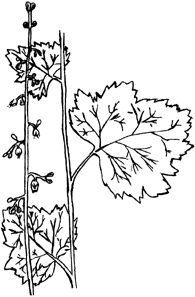
I LLUSTRATION 1 Alumroot
Alumroot(Heuchera) typically grows on rocks in open woodland areas and reaches a height of one to two feet The leaves are usually parted into three or five divisions and are cleft and toothed. Flowers from this plant are small and white or green. Roots are usually thick and two to four inches long with several stem scars on the root showing old stem growth. The plant is gathered for the roots, which should be used before the spring flowering time of April through June. As the leaves get older, they are often spotted.
Alumroot has several uses as medicine. A tea brewed from the leaves is used for dysentery. A mixture made from the root is used for sore throats. Powdered root is also used on wounds to stop bleeding.
Clarence Lusk shared his experience with this root. The alumroot is a very spindly little ol stem that runs up out of the ground. It comes up very early in the spring, pretty much the first thing that comes up. Thats when I generally gather it. All it takes is two or three little ol roots as long as your finger to cure you usually. Ive got up in the morning, especially when I was working in the woods in the forestry business, and Id be sick with dysentery. Id just say, Well, I just aint gonna get to work today. Thats all there is to it! While my wife was getting breakfast, Id go out and dig up some of them herbs and make a cupful of tea and drink it. Then Id eat a pretty good breakfast and go right on to work, and that was the end of my sickness.
Font size:
Interval:
Bookmark:
Similar books «Mountain Folk Remedies»
Look at similar books to Mountain Folk Remedies. We have selected literature similar in name and meaning in the hope of providing readers with more options to find new, interesting, not yet read works.
Discussion, reviews of the book Mountain Folk Remedies and just readers' own opinions. Leave your comments, write what you think about the work, its meaning or the main characters. Specify what exactly you liked and what you didn't like, and why you think so.

